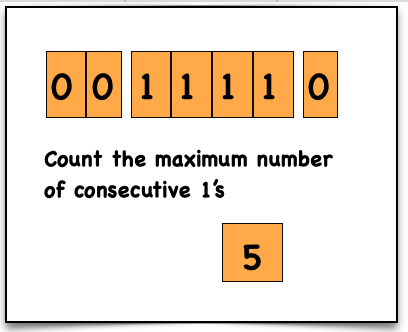Back to course
Max Consecutive Ones
Content Reader1 words • 0:00 • Browser TTS

Max Consecutive Ones
Problem Statement:
Given a binary array nums, return the maximum number of consecutive 1’s in the array.
Example 1:
Input: nums = [1,1,0,1,1,1]
Output: 3
Explanation The first two digits or the last three digits are consecutive 1s. The maximum number of consecutive 1s is 3.
Example 2:
Input: nums = [1,0,1,1,0,1]
Output: 2
Constraints:
- 1 <= nums.length <= 105
- nums[i] is either 0 or 1.
Optimal Approach: Single Pass
- Initialize two variables:
currentCount→ to count current streak of 1smaxCount→ to keep track of the maximum streak seen so far- Traverse the array:
- If
nums[i] == 1, incrementcurrentCount. - If
nums[i] == 0, comparecurrentCountwithmaxCount, updatemaxCount, then resetcurrentCountto 0. - After the loop, return the maximum of
maxCountandcurrentCount(to handle case where array ends in 1s)
Visualisation:

Time Complexity:
- Time Complexity = O(n)
- One pass to shift non-zero elements.
Space Complexity:
- Space Complexity = O(1)
- No extra space used beyond a few variables.
Dry Run
Input: nums = [1, 1, 0, 1, 1, 1]
i = 0 → nums[i] = 1 → currentCount = 1
i = 1 → nums[i] = 1 → currentCount = 2
i = 2 → nums[i] = 0 → maxCount = 2, currentCount = 0
i = 3 → nums[i] = 1 → currentCount = 1
i = 4 → nums[i] = 1 → currentCount = 2
i = 5 → nums[i] = 1 → currentCount = 3
Output: max(2, 3) = 3
JavaScript Code
var findMaxConsecutiveOnes = function(nums) {
let currentCount = 0;
let maxCount = 0;
for (let i = 0; i < nums.length; i++) {
if (nums[i] == 1) {
currentCount++;
} else {
maxCount = Math.max(currentCount, maxCount);
currentCount = 0;
}
}
return Math.max(maxCount, currentCount);
};

Written by Rahul Aher
I'm Rahul, Sr. Software Engineer (SDE II) and passionate content creator. Sharing my expertise in software development to assist learners.
More about me